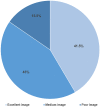Image quality and related outcomes of the ShuntScope for catheter implantation in pediatric hydrocephalus-experience of 65 procedures
- PMID: 36459211
- PMCID: PMC10024658
- DOI: 10.1007/s00381-022-05776-1
Image quality and related outcomes of the ShuntScope for catheter implantation in pediatric hydrocephalus-experience of 65 procedures
Abstract
Purpose: Ventricular catheter implantation in pediatric hydrocephalus can become a highly challenging task due to abnormal anatomical configuration or the need for trans-aqueductal stent placement. Transluminal endoscopy with the ShuntScope has been invented to increase the rate of successful catheter placements. This study aims to evaluate ShuntScope's image qualities and related surgical outcomes in the pediatric population.
Methods: A retrospective analysis of all pediatric patients undergoing ventricular catheter placement using the ShuntScope from 01/2012 to 01/2022 in the author's department was performed. Demographic, clinical, and radiological data were evaluated. The visualization quality of the intraoperative endoscopy was stratified into the categories of excellent, medium, and poor and compared to the postoperative catheter tip placement. Follow-up evaluation included the surgical revision rate due to proximal catheter occlusion.
Results: A total of 65 ShuntScope-assisted surgeries have been performed on 51 children. The mean age was 5.1 years. The most common underlying pathology was a tumor- or cyst-related hydrocephalus in 51%. Achieved image quality was excellent in 41.5%, medium in 43%, and poor in 15.5%. Ideal catheter placement was achieved in 77%. There were no intraoperative complications and no technique-related morbidity associated with the ShuntScope. The revision rate due to proximal occlusion was 4.61% during a mean follow-up period of 39.7 years. No statistical correlation between image grade and accuracy of catheter position was observed (p-value was 0.290).
Conclusion: The ShuntScope can be considered a valuable addition to standard surgical tools in treating pediatric hydrocephalus. Even suboptimal visualization contributes to high rates of correct catheter placement and, thereby, to a favorable clinical outcome.
Keywords: Endoscopy; Pediatric hydrocephalus; ShuntScope; Shunting; Ventricular catheter.
© 2022. The Author(s).
Conflict of interest statement
There are no competing financial or non-financial interests. Joachim Oertel acted as a consultant for Karl Storz Company for spine surgery until 2020. No conflicting interests exist for the material and technique mentioned in the publication.
Figures









Similar articles
-
Image Quality and Related Outcomes of the ShuntScope-Guided Catheter Implantation in Adult Hydrocephalus: Experience of 63 Procedures.J Neurol Surg A Cent Eur Neurosurg. 2024 Jul;85(4):340-348. doi: 10.1055/s-0043-1769126. Epub 2023 Aug 21. J Neurol Surg A Cent Eur Neurosurg. 2024. PMID: 37604196
-
The view through the ventricle catheter - The new ShuntScope for the therapy of pediatric hydrocephalus.J Clin Neurosci. 2018 Feb;48:196-202. doi: 10.1016/j.jocn.2017.10.046. Epub 2017 Nov 6. J Clin Neurosci. 2018. PMID: 29102235
-
Improvement in clinical outcomes following optimal targeting of brain ventricular catheters with intraoperative imaging.J Neurosurg. 2014 Mar;120(3):684-96. doi: 10.3171/2013.8.JNS13250. Epub 2013 Oct 11. J Neurosurg. 2014. PMID: 24116721
-
Hydrocephalus and shunts in children with brain tumors.J Pediatr Oncol Nurs. 1995 Oct;12(4):223-9. doi: 10.1177/104345429501200408. J Pediatr Oncol Nurs. 1995. PMID: 7495527 Review.
-
Lung destruction secondary to intrapulmonary migration of a ventriculoperitoneal shunt catheter: report of an unusual case and literature review.Childs Nerv Syst. 2021 Mar;37(3):989-993. doi: 10.1007/s00381-020-04716-1. Epub 2020 Jun 9. Childs Nerv Syst. 2021. PMID: 32514761 Review.
Cited by
-
Considerations on surgical strategies and associated risk profiles for endoscopic tumor biopsies within the third ventricle and periaqueductal region.Childs Nerv Syst. 2023 Dec;39(12):3407-3414. doi: 10.1007/s00381-023-06122-9. Epub 2023 Sep 8. Childs Nerv Syst. 2023. PMID: 37682304 Free PMC article.
-
Assessment of the efficacy and safety of neuroendoscopic procedures for intracranial pathologies: A single-centre retrospective study with 318 intracranial endoscopic procedures.Brain Spine. 2024 Nov 22;4:104142. doi: 10.1016/j.bas.2024.104142. eCollection 2024. Brain Spine. 2024. PMID: 39669717 Free PMC article.
-
Endoscopic placement of a triventricular stent for complex hydrocephalus and isolated fourth ventricle: illustrative case.J Neurosurg Case Lessons. 2023 Nov 6;6(19):CASE23153. doi: 10.3171/CASE23153. Print 2023 Nov 6. J Neurosurg Case Lessons. 2023. PMID: 37931250 Free PMC article.
References
-
- Hsia CC, Chen YH, Wu HY, Liu MY. The misplacement of the external ventricular drain by the freehand method in emergent neurosurgery. Acta Neurol Belg. 2011;111:22–28. - PubMed
MeSH terms
LinkOut - more resources
Full Text Sources
Medical

